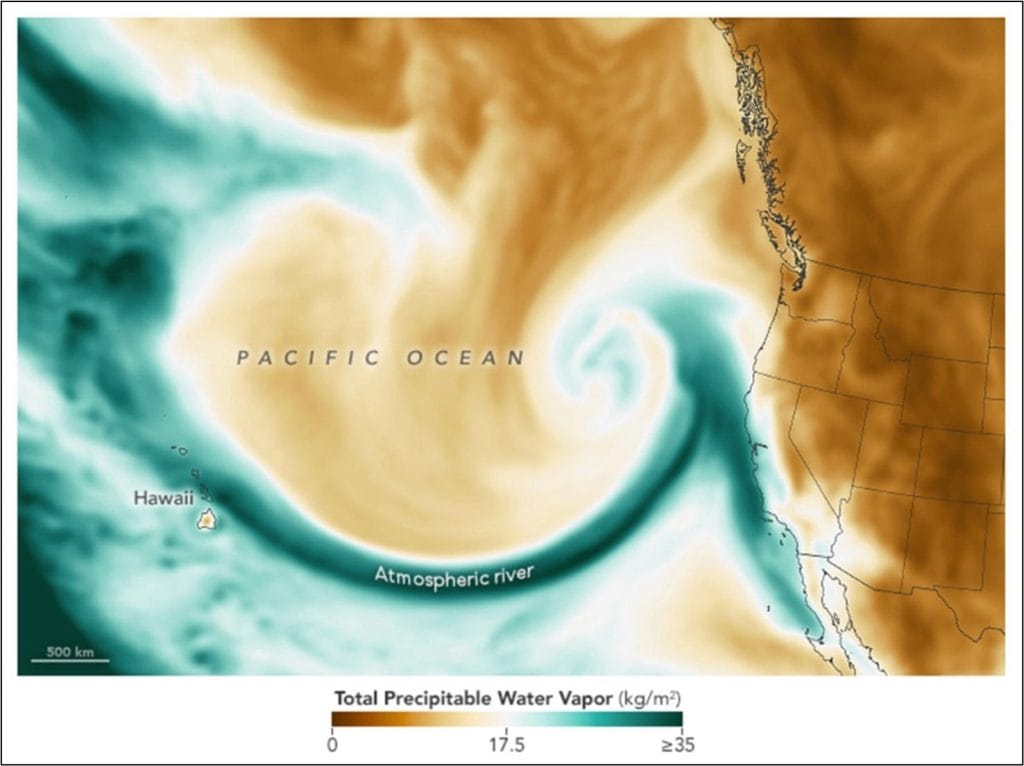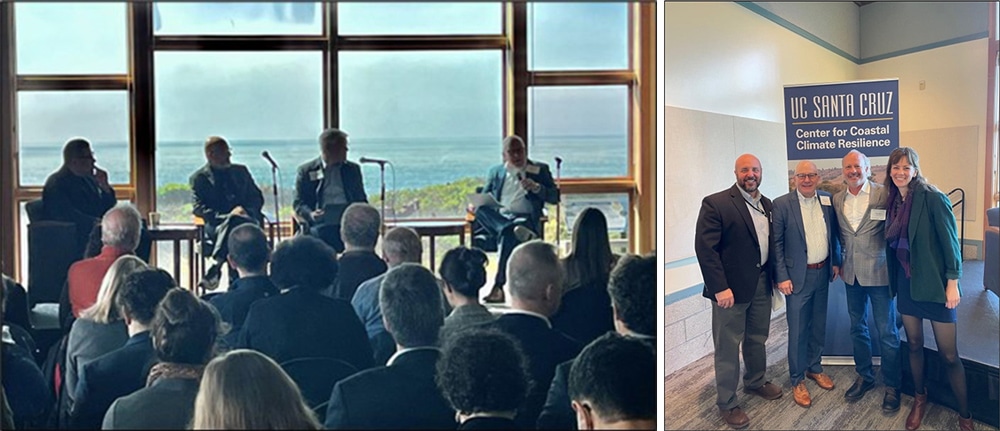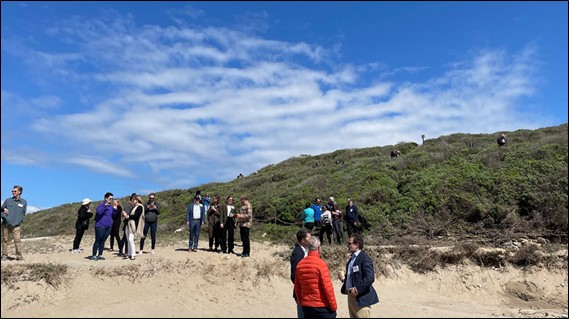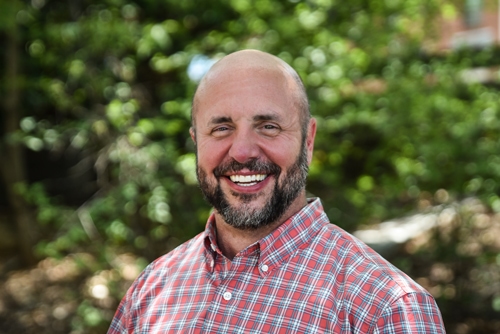Climate change is increasing coastal hazards and putting people who live and work in coastal communities at risk. Host Sarah Thorne and Jeff King, National Lead of the Engineering With Nature® Program, welcome back Mike Beck, Director of the new Center for Coastal Climate Resilience at the University of California in Santa Cruz. Mike was a guest on Season 1, Episode 6. Mike is actively working to understand the role that ecosystems play in providing natural defenses for both people and property. By combining innovative nature-based solutions with insurance incentives, he hopes to significantly increase coastal resilience.
The State of California recently invested $20 million into UC Santa Cruz to establish the Center for Coastal Climate Resilience. As Mike says, “Climate change is no longer a ‘future’ problem. It’s a ‘here and now’ problem. So, the State Legislature is investing in actions toward solutions that we need to be able to adapt and build resilience to these changes.” With the recent atmospheric rivers causing extreme weather conditions and flooding in California, Jeff adds, “We’re certainly seeing climate change happen in real time. Climate change is here.”

Mike notes that the Center is committed to a diverse approach, focusing both on nature-based solutions and on underserved communities, similar to the approach the federal government is taking. “A couple of things that we hope will really set the Center apart are that, even though we are university based, we are very solutions oriented. We’re thinking about what we can do to help reduce risks and help people adapt. At the same time, we’ve got programs that are really going to help us understand the equity considerations of how we do this. We really need to think about ways to understand the risks that some of these underserved communities are facing.”
As Mike described in his previous appearance on the EWN Podcast, there is a positive symbiotic link between nature and insurance. Natural features can provide protection against insured property damages from storm surges, and incentives in insurance policies can encourage property owners to build and sustain such natural features. He expands on that concept in this episode by describing the larger roles of nature and insurance in helping to build more resilient communities, noting that reefs and wetlands reduce waves and storm surge, thereby reducing the amount of flooding and erosion. “Reefs work by breaking waves. They dissipate that wave energy offshore so that you can be standing onshore, say for example in Hawaii, with teeny little waves lapping up at your feet, while you’re watching surfers offshore on 15–20 foot waves. That’s the reef providing services offshore, reducing that wave impact.”

Mangroves and marshes reduce waves too, but they really reduce storm surge by acting like a dam as storm surge comes in. “In southwest Florida around Hurricane Ian, if you look at some of the before and after photos published by the National Oceanic and Atmospheric Administration (NOAA), the areas where we’ve left mangroves in place saw very little damage. Areas where we either built on top of, or even in front of mangroves, showed really devastating and heartbreaking damage,” Mike explains. “So, getting back to insurance, mangroves are really important for reducing risks and payouts if you leave them in place.”
Mike says another aspect of interest to insurers is insuring nature as an asset in an of itself. He describes the insurance policy developed for the Mesoamerican Reef, just south of Cancun in Mexico. “The idea is that reefs are a natural seawall and an important part of our natural infrastructure. It can be damaged by storms. So, storm damage topples over corals, and they go back into the lagoon. Those corals rolling around in the lagoon have about two weeks to live unless somebody is being supported to get in the water, get those back on the reef and glued back in place. An insurance policy like this pays out immediately after certain storm events, supporting those activities so that we can start to revitalize the reef.” He adds, “The industry still has a way to go, but they can play an even greater role in helping to reduce those risks. It’s in their best interest because, as we’re looking at a climate changed future, insurance is going to get more expensive—out of reach for some communities—unless we’re doing things now collectively, both publicly and privately, to reduce those risks.”
The need to reduce risk was the impetus for the recent Coastal Climate Resilience Symposium, a collaboration between UC Santa Cruz, the California Ocean Science Trust, the California Department of Insurance, and the Engineering With Nature Program. Held at the Seymour Marine Discovery Center at UC Santa Cruz, the symposium brought together coastal scientists, insurance industry experts, and representatives of state and federal agencies. As Mike describes it, “The purpose of the symposium was to get these diverse thinkers together to talk about how we reduce risks for these communities using both nature and insurance. We wanted to combine forces between risk managers on the state and federal side and with the risk industry and NGOs on the private side to help reduce risk for people and nature.” Jeff adds, “What really came across early on for me was the energy in the room, the enthusiasm for this topic, the senior leaders that were participating in these discussions, and the commitment they had to seeing this through. They recognized the intersection of insurance and natural infrastructure, and they wanted to get there.”
According to Mike, “The US Army Corps of Engineers is not very familiar with insurance. It’s not a regular feature of what they do. But the Corps has enormous influence on the industry—I’m thinking about the damage curves that are used worldwide that say if a house is flooded by a certain amount of water, here’s how much damage happens to that kind of structure. And that damage is different if it’s a mobile home versus a two-story house. The Corps has been central to developing such assessments, along with other risk models. Now we’re trying to make that role even tighter, particularly with nature in mind, of how we assess nature’s benefits.”

The coastal setting of the symposium helped to spur discussion and collaboration. “We had a very nice beach walk where folks could get outside, go down and look at the waves, think about what that means in terms of flooding, think about the habitats that are providing the protections,” Mike says. “I had some folks come to me from the insurance industry and say, ‘I just met some of these other folks here who are doing similar work to us and we just started to devise a mangrove insurance project that we think could really work out.’” Jeff adds, “The idea of public-private partnerships figures into the equation for success. We can have government and the private sector working together to advance the development of infrastructure—in this case, having the insurance industry investing in natural infrastructure features that provide some degree of risk reduction. This sort of symbiotic relationship will ultimately get us to the desired endpoint. From where I sit, this is moving very quickly now, so we will continue to see a lot more success.”

Mike and the Center have formally joined the Network for Engineering With Nature (N-EWN). As Jeff says, “This expands our long-time collaboration with Mike and gives him and his team, along with his students, the opportunity to collaborate with the other diverse member organizations. This will really accelerate our understanding and collaboration on research to promote and expand knowledge in this space. Having Mike there to offer his perspective, his knowledge, and be able to teach and inspire the next generation of engineers and scientists is just fantastic.”







